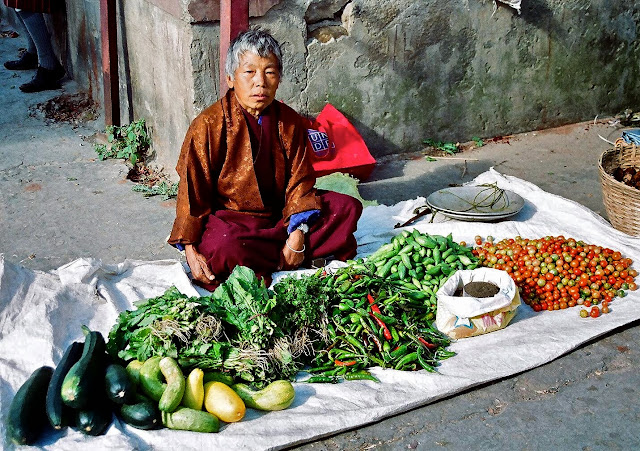http://expatteacherinthailand.blogspot.com/2009/11/visit-to-bhutanese-monastery.html
Following are selected portraits of the people of Bhutan. They are digitized photos from 100 ASA Kodak negative film. For more information about Bhutan, including the national dress, visit bhutan.com. Next post: Scenes and scenery in Bhutan.
(Photos by the author. All rights reserved. Do not use without permission.)
 |
| The swirl of colors are everywhere: in the clothing, the ornate and brightly painted storefronts, in the temples and altars. Here a woman with her baby strolls by storefronts in Paro. |
 |
| This woman wanted me to wait until she had arranged her clothing just right for her portrait. Taken along the main street in Paro. |
 |
| Many Bhutanese Buddhists carry prayer beads, as this woman has. Photo taken in Paro. The deeply lined faces of the elders in Bhutan reflect life in the sun-drenched high altitudes. |
 |
| This baby and her father exude much of the enjoyment we saw in Bhutan, whose well-being is measured in what they have coined "Gross National Happiness". |
 |
| A monk rests at a temple in Paro. The ornate painted carvings that enhance the architecture are enchanting. |
 |
| A young monk at a lakhang, or temple. |
 |
| At a mountain monastery school, students make ornaments for altars. |
 |
| Monastery students practice Buddhist chants and songs with traditional mountain horns. |
 |
| Two of the elders at the monastery. The young man on the right was a student, and is now a teacher at the school. |
 |
| A young storekeeper peers out as a customer with her sleeping baby looks over the merchandise. Paro. |
 |
| A curious boy peers at the foreigners in Thimphu, the capital city. |
I have found that one of the best places in any country to meet people and to watch their interactions is at the local market. Below are scenes from the fresh market at Paro.
 |
| Men examine the quality of ceremonial cymbals. |
 |
| People bring their home-grown produce to Paro's market and simply spread it out on a sheet. A simple scale is to the right of the vendor. |
 |
| As in many towns throughout the world, the local market is also the center of the community social scene. |
 |
| Here vegetables are weighed using a traditional balance scale. The counterweight can be seen in the dish in the foreground. |
 |
| Smoke from vendors' charcoal grills rises in the early morning mountain air. |
 |
| A woman keeps warm against the chilly October air. |
 |
| Customers choose the best quality vegetables and place them on the scale held by the vendor. |

No comments:
Post a Comment